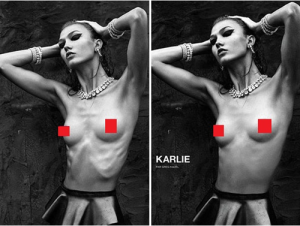What with the ‘fitspiration’ trend last year, there has been even more discussion around healthiness and its relationship to weight and beauty recently. But it turns out there’s more: as my excellent friend Elli Harris pointed out to me, PhotoShop has been playing its part – for decades – in creating a myth of healthy thinness.
It was this image of Karlie Kloss in the Huffington Post’s recent article that really caught my eye: Kloss is one of the most successful models around at the moment, and although we might in our knowing cynicism presume that her photos are retouched, I for one didn’t expect them to use PhotoShop to make her fatter.
I mean, we all know models nowadays are ‘too thin’, and they are constantly criticised for promoting an unhealthy level of skinniness. But it seems we haven’t been seeing the full truth of this, since the magazines and advertisers have been quietly erasing protruding ribcages, sunken cheeks and atrophied thigh muscle. This reveleation comes from former Cosmopolitan editor Leah Hardy, who wrote in The Daily Mail (of all places) that this has been happening for years.
As she explains, the industry is trapped in a cycle where designers send ever-smaller sample sizes to photoshoots, so the model agencies have to send ever-smaller models. Having booked exotic locations, top photographers, stylists and designer clothes at vast expense, you can’t really send home a model who turns up looking anorexic and ill, with acne, visible bones and dark circles under her eyes. You can, however, retouch her.
As the pieces in the Huffington Post and the Mail point out, this may have been done with good intentions – not wanting to promote an unhealthy ideal – but the result is that we don’t see just how unhealthy the ideal is. After all, Karlie Kloss still looks very thin in the retouched image above.
I think that the current obsession with health – often billed as a corrective to thinness – is in a dangerous position when this is how health is pictured: as the before and after image of Cameron Diaz above shows, artificial health is superimposed onto a slimness which physically cannot be that healthy. It’s the very definition of an impossible ideal. And if that’s what we think health looks like, then our self-esteem won’t be any better than when weight-loss was the goal.
Irony of the day: our Cameron has a new book out on how to be healthy. How much retouching, I wonder?





